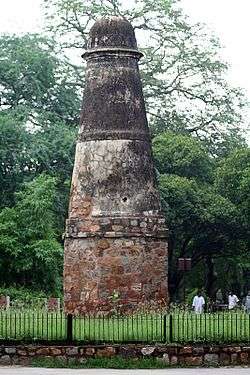Kos Minar


The Kos Minars or Mile Pillars are medieval milestones that were made by the 16th-century Afghan Ruler Sher Shah Suri and later on by Mughal emperors. These Minars were erected by the Mughal Emperors on the main highways across the empire to mark the distance. The Kos Minar is a solid round pillar, around 30 feet (9.1 m) in height that stands on a masonry platform built with bricks and plastered over with lime. Though not architecturally very impressive, being milestones, they were an important part of communication and travel in a large empire.
Kos Minars were used to mark the royal route from Agra to Ajmer via Jaipur in the west, from Agra to Lahore via Delhi in the north and from Agra to Mandu via Shivpuri in the south. Modern Indian highways have come up along roughly the same routes as those marked by these minars.
History
Kos is an ancient Indian unit of distance. It can represent either a distance of approximately 1.8 kilometres (1.1 mi) or 3.2 kilometres (2.0 mi). Minar is a Persian word for tower. Abul Fazl recorded in Akbar Nama that in the year 1575 AD, Akbar issued an order that at every Kos on the way from Agra to Ajmer, a pillar or a minar should be erected for the comfort of the travelers.[1][2]
Apart from these, many caravanserais (roadside inns) were also built for the tired and weary travellers.
Later additions
Kos Minars became an institution during the rule of the Mughals that Emperor Jahangir and Shah Jahan,following in their predecessors footsteps added to the existing network of Kos Minars. In the north they were extended as far as Peshawar and in the east to Bengal via Kannauj. The geographic span makes for nearly three thousand kilometers of Mughal highways, accounting for nearly 1000 Kos Minars, i.e., 1 every Kos or 3 kilometres (1.9 mi). There is no record as to how many of them have survived.
Preserved monuments
Over the years these road monuments have gone into a state of disrepair and are almost lost in obscurity. Along India's old highways, particularly the Grand Trunk Road, one still finds Kos Minar.
According to a report of the Archaeology Survey of India, there are 49 Kos Minars in Haryana.[3] There are also five kos minars around Ludhiana city.[4] Of late some of these Minars have been restored and attempts for preserving many others are ongoing.
There is a preserved Kos Minar in Lahore, near the tomb of Ali Mardan Khan. It probably lined the original G.T. Road, a few hundred meters north of it.
See also
- List of Monuments of National Importance in Haryana contains over a dozen Kos Minars in Ambala, Faridabad district, Palwal, Rohtak district, Sonepat district, Panipat district, Karnal district and Kurukshetra district
- Tourism in Punjab, India
References
| Wikimedia Commons has media related to Kos Minar. |
- ↑ Kos Minar University of Alberta.
- ↑ Nivedita Khandekar (October 27, 2012). "A milestone on the highway - Hindustan Times". Retrieved 2013-09-23.
- ↑ "Signposts lost in history". The Sunday Tribune. September 10, 2006. Retrieved 2013-09-23.
- ↑ "'Monumental' treasure house". The Times of India. Jul 12, 2009. Retrieved 2013-09-23.